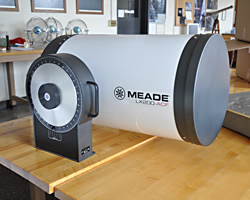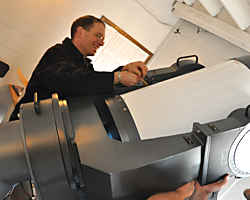Telescope
Offers Closer View of Space Phenomena

The new Meade telescope awaiting installation.
 Lowenthal tightening the final screws during the installation of the telescope. |
It’s International Astronomy Year and, fittingly,
a new telescope just arrived in Smith’s astronomy department
that will enable direct views of distant galaxies, rings
and satellites around Saturn, surface features on Mars and
much more.
The new Meade LX200 ACF,
a $13,000 telescope installed this week in the rooftop
observatory of McConnell Hall, replaces a 15-year-old Meade
telescope that wasn’t functioning
sufficiently.
“We sank lots of time and resources into trying to
get the old one to work,” explained James Lowenthal,
associate professor of astronomy. “The optics, unfortunately,
never worked properly.”
With the new telescope,
space observers will be able to view objects in space more
than 3,000 times fainter than those visible to the naked
eye, said Lowenthal. “It
will afford direct views of galaxies tens of millions of
light years distant, gaseous nebulae in our own Milky Way
galaxy, where clusters of stars are being born, the glowing
remnants of supernovae and other stellar corpses, storms
in the atmosphere of Jupiter, phases of Venus, and craters
on the Moon as small as a mile across.”
The telescope will be
used for classes such as AST 337, Observational Techniques
of Optical and Infrared Astronomy, in which students learn
to use professional tools of the trade, as well as for
astronomy department “star parties” and
for research projects.
Already, the new telescope
has yielded spectacular views, said Lowenthal, who gathered
with colleagues earlier this week to take a look. “We are all delighted to report
that the telescope performs exceptionally well optically,
mechanically and electronically,” he said. “I
got fabulous views of Saturn plus six satellites.”
The telescope was purchased with proceeds from the Ethel
Farrington Fund, which was bequeathed to the physics and
astronomy departments for research and educational equipment.
The new telescope will
likely get plenty of use in upcoming sky-viewing sessions
as part of the astronomy department’s
participation in the . Stop
by McConnell for the next star gazing open house on Thursday,
April 2, 8:30-9:30 p.m. to see it for yourself.
View more photos of the installation. |























